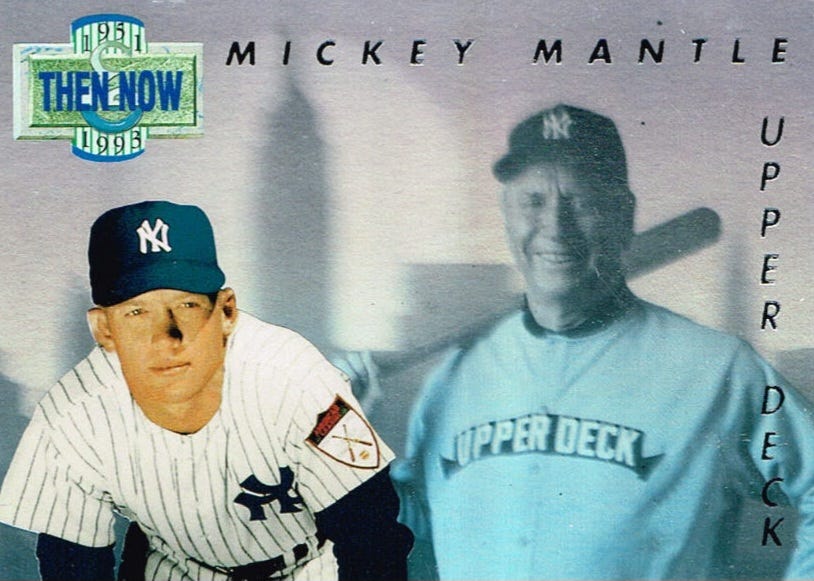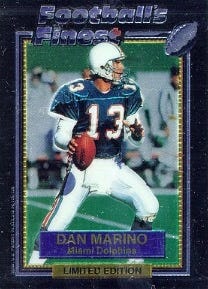The Battle for Chrome Refractors
Introduction
In late-1991, Upper Deck was at the top of the baseball card mountain after only three years in business. In 1989, with Topps and other card manufacturers like Donruss & Fleer asleep at the wheel, Upper Deck entered the market and introduced premium baseball cards to the collecting world. The following year, Upper Deck beat all their competitors to the punch by introducing the first ever pack-inserted, certified autograph. The world of sports trading cards was in Upper Deck’s complete control.
One can imagine finding immediate success being a good reason to rest on one’s laurels but Upper Deck was already hard at work creating their next big innovation; full, holographic baseball cards. To Upper Deck, it must have been looked at as a can’t miss opportunity. Step one, premium cards. Step two, autographs in packs. Step three? Holograms. You could even excuse some arrogance as by this point, everything Upper Deck touched seemed to turn into sports card gold.

The Meeting That Forever Changed Sports Cards
Craig Taylor and his associates walked into Upper Deck’s Carlsbad office in late 1991 with his genius creation in a black briefcase. His company, Signs & Glassworks, INC. had been working with printing technology since the late-80s and had taken an interest in the premium baseball card market, which was now all the rage. His idea was simple: baseball cards could one day be printed on more than just cheap cardstock. With that little idea, Taylor set forth on creating, unauthorized Upper Deck “Chrome” baseball cards to pitch directly to Upper Deck in a top secret meeting, which included the legendary Richard McWilliam.
Only Craig knows how many prototypes Signs & Glassworks produced (and he’s tight-lipped today) but what is known, thanks to my sources at Upper Deck and PSA Grading & Authentication, is that exactly 20 different subjects of the Upper Deck Chrome prototypes were created for the pitch meeting and since 1991, only a handful have surfaced and have been submitted to PSA (all rejected). My source, who has asked to remain anonymous, says that the most Chrome prototypes that have been submitted to PSA of any one single player is five.

Furthermore, my source tells me that Upper Deck officials were perturbed that Signs & Glassworks took it upon themselves to produce unauthorized copies of Upper Deck trademarked baseball cards. The risk that these “counterfeit” cards posed were enough to bring an abrupt end to any possible deal between the two companies. MLB was beginning a war on “Broder” counterfeit cards during this period and Upper Deck didn’t want to risk these prototypes leaking into the secondary market and possibly causing a rift between the manufacturer and MLB.
The prototypes were left at Upper Deck’s office and Craig jumped into his car for the twenty minute drive to his San Marcos warehouse to begin work on his next project; a Chrome prototype card to pitch to Upper Deck’s main rival, Topps Company. By the end of that week, Upper Deck employees tossed the experimental Chrome prototypes in their dumpster and forgot all about Signs & Glassworks and their disastrous meeting.
One Man’s Trash, Another Man’s Priceless Treasure
This is the point in our story where we meet “Miguel”. Miguel’s name has been changed to protect his identity. In 1991, Miguel was a retired United States Marine who was working in Carlsbad, California as a security guard for Upper Deck. Miguel was aware, as were many other employees, their families, and even kids around town, that Upper Deck was known for discarding mountains of baseball cards, including uncut sheets, as well as misprinted/error cards, usually on the night before their dumpster was to be emptied by the city. This was a measure used to keep would be prowlers and collectors looking for free cards not suitable for consumers, away.
On Upper Deck’s dump day, Miguel asked his supervisor for permission to grab some discarded baseball cards for his young son, a huge Oakland Athletics and Jose Canseco fan from the dumpster. Upper Deck gave Miguel permission without hesitating. Unfortunately, on that day, the only cards discarded were three, metallic baseball cards of Jose Canseco. Miguel grabbed all three, gave two away to his fellow co-workers and took one home for his son. His son, “PJ”, eventually grew out of collecting baseball cards but kept the prototype card tucked away for over three decades.

As for Craig Taylor’s brilliant idea, he didn’t give up despite Upper Deck’s cold rejection. Craig went on to create a generic Chrome card for Topps Company, to much better results. This time around, Craig produced his own design, airbrushed out NFL logos, and didn’t include Topps’ own trademarked name in the final print to prevent a repeat of the embarrassing Upper Deck meeting.
By all accounts, Topps Company executives fell head over heels in love with the prototype and its seemingly endless potential and signed on the dotted line. Just a year later, 1993 Finest was introduced to the baseball market, with the parallel we all know and love, the Refractor, by its side.

The Aftermath
One cannot underestimate how important that chrome prototype was. Upper Deck eventually released full hologram baseball cards as inserts in their flagship and eventually as its own brand, called SPx, but by 1998, Upper Deck made the surprising decision to move away from holograms to focus on game-used memorabilia cards.
My source at Upper Deck revealed that hologram technology took much longer than traditional photographs for sports cards, was more expensive to produce and when several star players complained to their agents about having to sit for long periods of time, they knew the writing was on the wall.
While it can be argued that Upper Deck dominated baseball cards for the next 5-7 years, once Topps introduced the 1/1 Superfractor, based directly on the Chrome technology created by Signs & Glassworks, the same technology Upper Deck had first dibs on and chose to pass on, the Baseball Card War was officially over.
Upper Deck was essentially gifted Thanos’ Infinity Gauntlet to finish off its rivals but for one reason or another, decided to pass on the technology, leaving it open to Topps Company, who in this case, was Iron Man, ready and more than willing to snap its fingers and eliminate what to this point had been the only company to give them real competition in 50+ years.
The ramifications of that meeting with Signs & Glassworks are sadly still being felt today as Upper Deck hasn’t produced licensed baseball cards since 2009. The once revered card manufacturer also went on to lose the NFL and NBA licenses and today are on the fringe of the industry they once ruled, producing NHL, Marvel, and AEW trading cards to little fanfare.
Stay tuned and make sure you are following on X and are subscribed on Substack.



